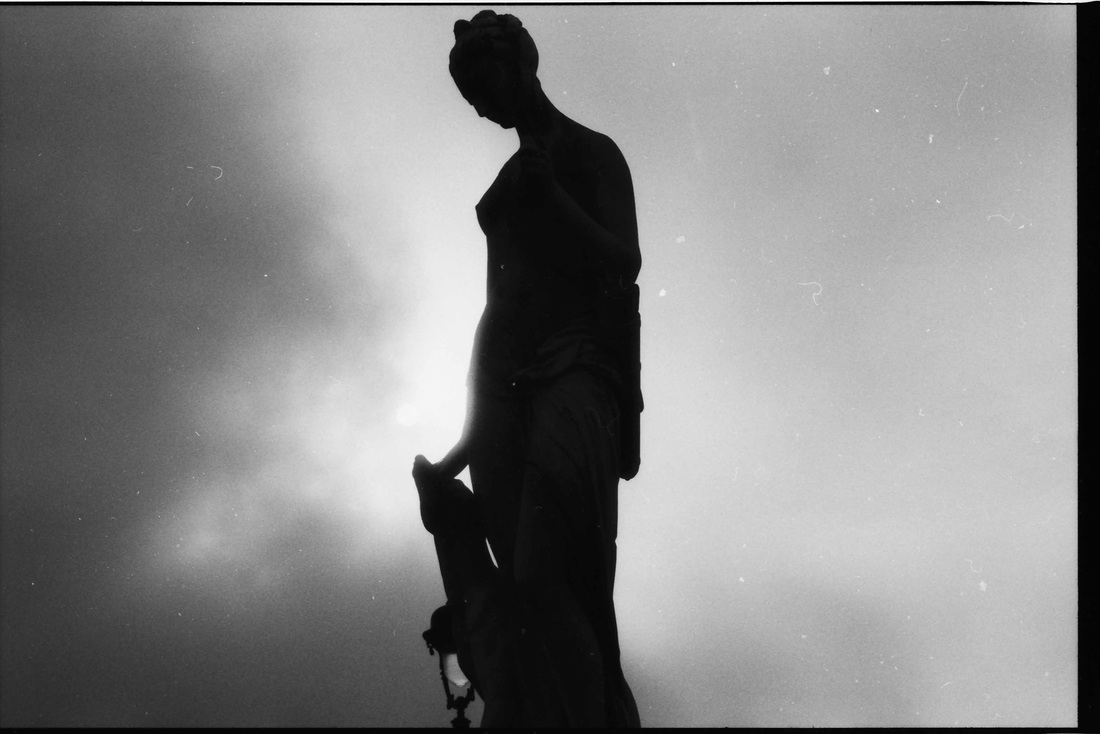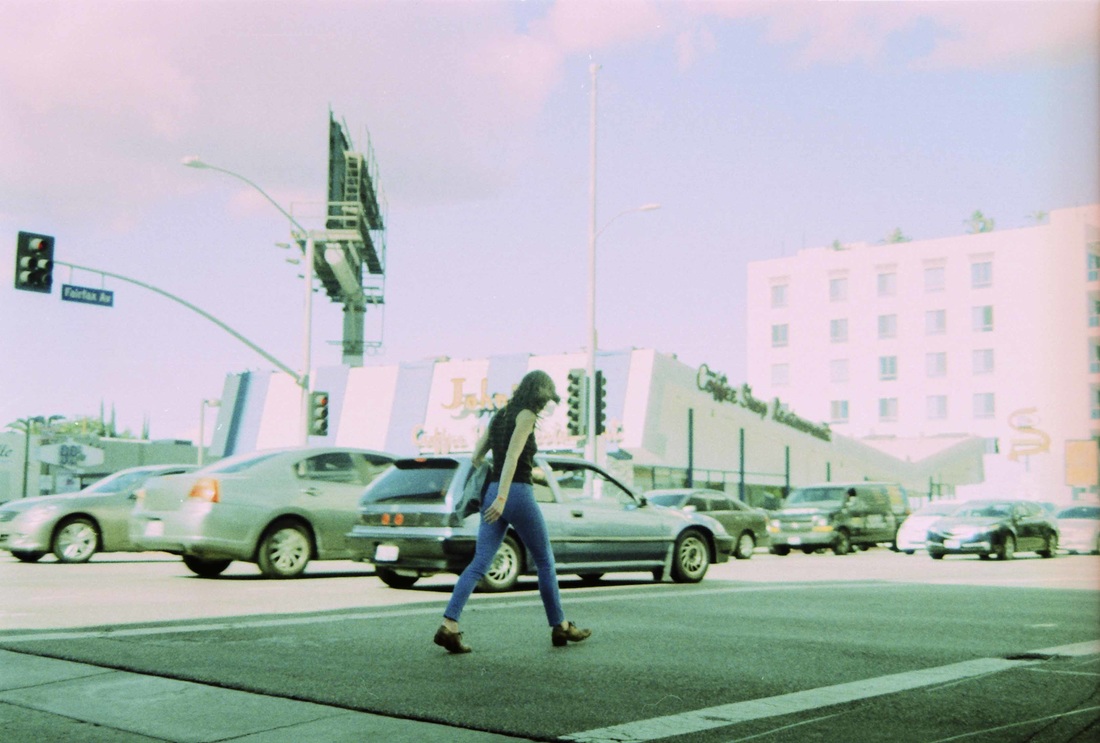|
The night was silent. We ambled forward together, a mobile living room, lightly populated with benevolent strangers. Nothing but the gentle hum of the bus's electric current. People sitting alone, nursing their own thoughts.
Then out of the silence, like cymbals crashing after a mellow adagio, I hear an ear-splitting stentorian roar: "DRIVER DO YOU LIKE DONALD TRUMP?" So inquired the great Mr. Weyling (read more here and here). In retrospect, it's strange he'd been quiet up until that point. Maybe he'd belatedly realized he was out of character, and felt the need to set things right. This funereal silence just won't do. Time for some classic Weyling. I responded in a normal, easygoing voice: "Um, we're not gonna talk about politics on the bus tonight." "OKAY," he boomed. "Yeah, we're gonna keep that to ourselves." Talking to him, and to myself. "OKAY. I'LL KEEP IT A SECRET WHO I'M VOTING FOR." "Thanks, man." Weyling's wailing is like no one else's. He might be my favorite shouting person to listen to. Yes, the list is short, but he's at the top! His diction is precise, Christoph Waltz's, and unhurried, like Jason Robards'. The difference, as I've mentioned before, is volume. Kakapo parrots and Blue Whales have nothing on this guy. Reader, I'm not making fun at his expense. He possesses a truthfulness of being not everyone has, and I stand by my earlier words, wherein I saw in him "an uncomplicated passion I find oddly adorable." There's something of the child in him, direct, and that I admire. Plus, well, doesn't all this make the evening more exciting? His line above was reeled off slowly, and the effect was unique; we're accustomed to yelled declarations that carry significant meaning or emotion. We expect them to be said quickly and heatedly. Less ordinary is hearing thunderous levels applied to highly innocuous statements of no great emotional import. I couldn't not smile. I recall a moment strolling down Third Avenue some weeks ago. Mr. Weyling was a bit ahead of me, his short, compact figure bobbing up down amongst the dense crowd– we as a city were impersonating a packed New York sidewalk. His hunched shoulders, furrowed brow, and italicized forward momentum were the very picture of determination. He stood out from the others in that he was giving himself some positive self-talk– something I hope we all do, but he was unique in not exactly keeping it to himself. Repeatedly, he would bellow out, "TRY TO TELL ME I CAN'T? I THINK I CAAANNNNN! TRY TO TELL ME I CAN'T? I THINK I CAAAANNNN!" He howled it to the skyscrapers with malicious glee, practically shaking glass, flattening imaginary antagonists with each step. Nothing wrong with a little self-confidence, I thought. "I LIKE YOU AS A DRIVER," he slowly screamed, if a raspy bass voice can scream. "YOU'RE A NICE GUY." "I try." "I'LL TELL YOU WHO I WANNA BE LIKE." He paused dramatically. Let's take a moment and consider his use of "wanna." Contractions are used to accelerate delivery. Nobody says "wanna" slowly… ah, but Mr. Weyling isn't just anyone. He's Mr. Weyling. Don't you love this guy? He wrapped up his dramatic pause by concluding with the exclamation, "MY FATHER." I was about to say something admiring, something about it's nice to have good parents one can respect, but he bulldozed in with, "HE'S OVER SIXTY FIVE YEARS OLD, AND HE'S STILL WORKING." "Really!" At this point he stood. Which made sense. There was no other way to emphasize his upcoming point: he was already bellowing. He was already emphasizing each word. What else can you do? The only thing left to do is rise! He's Dr. King at the Lincoln Memorial. He's Patrick Henry at the Virginia Convention. He threw his hands in the air and turned his face to the skies. Sleepers and thugs alike seated nearby looked up groggily, utterly flummoxed. What were they to do with this great fulminating vision in front of them, this avalanche of friendly and deafening vehemence? "HE'S NOT GONNA STOP WORKING, UNTIL HE FEELS LIKE STOPPING WORKING!" "Uh huh, he likes to work?" My normal voice sounded like a puny pipsqueak compared to his. "HE'S OVER SIXTY-FIVE YEARS OLD! I WANNA BE LIKE THAT." Who else says 'wanna' as such a deliciously slow, perfectly enunciated detonation? "I MAY NOT MAKE IT, BUT I'M NOT GONNA GIVE UP." Goh-nnuh. "Don't give up!" "I COULD GIVE UP, BUT I'M NOT GONNA!" Personally, I find something beautiful about his complete lack of irony. In an age when everything needs to have a layer of hipper-than-thou ennui, he is sincere. He wants to follow in the footsteps of his father, and says so. With unremitting gusto. Shortly thereafter he deboarded, but just because the bus was driving away and he was no longer nearby didn't mean I couldn't still hear him perfectly. His half-a-block-away bellow read now as an ordinary voice right beside me. It said, "I aspire to my father." I was reminded of the great Novalis quote, where he writes, "I am always going home, always to my father's house." My philosophical reverie was shaken by further Weyling. He had other pertinent information he needed to share. I was all ears. "I PUT ON COLOGNE!" he screamed, with the urgency of an untamed drill sergeant. "A LITTLE DAB HERE, AND A LITTLE DAB THERE!"
8 Comments
To my fellow humans the terrorists,
Before you pull your next trigger, I would ask for a pause, not for my sake but yours: take in a full breath, and think of the smile on your mother's face. Think of the early times, when your parents were young, when sunsets lasted longer, when the biggest problem was schoolwork, acceptance from friends, or the hesitant expression on a pretty girl's face. Think of the taste of bread. Consider your goals now, and reflect on how they're all ultimately to do with loneliness, the search for belonging and respect and when we really get down to it, love. Know that I was all of those things too. My goals and memories are like yours, and as children we would've played together. The weight between your shoulders is one I can feel, different but familiar, a lack of love to be solved not with hate, but with love. We are all bitter over something. Let us not fight rigid ideologies with other rigid ideologies, or address violence and mayhem with the tools of violence and mayhem. In the business of fighting ideas, there is only one successful method: other ideas. The great battles of the twenty-first century will be intellectual battles. War is simplistic, and blinds with tragedy; it traffics more than perhaps anything else in nostalgia, and is outmoded and archaic as a problem-solving format. You are so much better than this, my friend. I am disappointed in you. You knew the face of goodness, once. I do not think you have completely forgotten how to see. -Nathan Vass As you know, I was present during last year's attacks in Paris. It hasn't felt right to share these photographs until now. Now it feels wrong not to share them. Click here for the galleries. Some weeks ago I posted a glowing review of SAM's recent Kehinde Wiley show, which I loved. I stand by every word of that review, but I'd like to add some context which I find troubling enough to consider necessary.
I knew when I saw the show that Wiley didn't paint everything in the paintings, but the implications of the blasé attitude toward this enormous fact didn't hit me until after taking in the show a second time. The most disappointing element is the lack of demand by writers, thinkers and viewers to know who made the paintings and how. When concept takes center stage in the appreciation of art, talent, skill, and craftsmanship get relegated to secondary levels of importance, which means the authors of that skill and how they accomplish their work becomes less consequential. To look through every one of the books on Wiley at the show and have none of them even address the multiplicity of authorship question is not simply an insult to viewers (does SAM expect us to think a thirty-six year-old is this skilled and prolific in painting, glass, bronze, and marble?), but an embarrassment on the part of the authors and curators themselves. It guides the discussion into that tiring realm where concept is king, and craftsmanship is discussed only with superlatives because critics who have no experience in the art form can't talk about it in depth, and thus focus only on what they, and anyone else with extensive knowledge in realms besides painting and sculpture, can: content. This divide becomes immediately apparent when listening to the difference between how tour guides talk when discussing art before vs. after the Modern period. Take a look at Fred Wiseman's mammoth fly-on-the-wall documentary National Gallery and listen to how the tour guides discuss Vermeer and Hans Holbein II. They talk about 1) craft and 2) how it expresses ideas. Tour guides of the Wiley show are saddled with the awkward task of discussing only the second part. I recall a particularly embarrassing moment at SAM wherein a viewer who happened to be a skilled stained-glass artist asked how a human hand could possibly accomplish the texture and shading of denim jeans on a single pane of glass, to which the poor tour guide had to reply that she had neither any idea how that was accomplished, nor who, or what, had accomplished it. We can be blunt and overstate the point by quoting Tom Stoppard: "imagination without skill gives us modern art." But I argue the real villains in this case are not the artists but those who shape the discussion. Tom Wolfe's The Painted Word is instructive here. To forget that content and form are inextricably linked is to miss much of what is beautiful about art and the decisions artists make. We've heard the phrase "style over substance" leveled against films as a criticism; as I've written elsewhere, you generally only hear that phrase from people who aren't filmmakers. The style in a worthwhile art piece is the substance. Style, or form, is the language through which the content is relayed to a viewer. Form lives and dies on the strength of the artist's talent. So what to make of Wiley, whom we know barely paints his own works. He declines journalist's visits to his studio, unless it's to have Martin Schoeller take a picture of him dabbing at a canvas while sitting atop a horse; tells reporters he doesn't want us to know to what degree his actual involvement is in the painting process, evading questions with coy comments about preserving his "secret sauce." Why? This is where he differs from Brueghel and Botticelli. No artist of great skill hides his skill behind a cloak of coy false modesty. If you didn't paint it, but your students did, it gets signed "School of Michelangelo." If you yourself did paint it, by God, you say so. We're talking about weeks or months of work. We're talking about the manly assertion of reputation and status here. In this world, if you've got it, you flaunt it. What artist in possession of such prodigious talent would leave their authorship in the murk? Wiley's works are hardly diminished, in my opinion, by learning that he only paints touch-ups on the faces and some of the skin tones, that the figures and floral pattern work are painted by Chinese laborers, that the sculpture work is done by assistants, and that the stained glass works are created entirely by individuals skilled in that realm (using photographs by Wiley as a base). That even this information is difficult to come by is disappointing on the part of Wiley and SAM, but also the lack of outcry on the part of viewers. I know what you're thinking. You're thinking, Chihuly. Koons. Crewdson. I say close, but no Kehinde. They're not quite appropriate as corollaries; these artists and others like them, who heavily involve assistants, don't shroud their processes in secrecy, but hold it open for all to see and determine the worth of the works. For heaven's sake, we all know Koons doesn't make his own stuff. There's another, more troubling reason why Wiley stands alone here. Unlike the folks above, Wiley's work is explicitly intended to counter the subjugation of marginalized (black) people in Western Art. Personally I love the idea. So far, so great. How does he accomplish this? By subjugating and rendering nameless the marginalized (Asian) peoples who create these artworks for him. He's eliminating subjugation one heroic step at a time, using: subjugation. Let's flip the races around and see how it sounds. The twenty-first century's wealthiest white artist creates enormous volumes of high-impact portraits of Asians, rescuing them from repression and facelessness, by farming out the work to nameless black laborers in developing countries worldwide. In gut-busting new levels of hubris, said artist refuses to credit or acknowledge the specific contributions of these black men and women in the name of preserving the mystique of his "secret sauce." We're in the middle of what should be the biggest conversation in art right now. Most items we consume are created by hardworking poor people across the world who get zilch recognition. As China continues to develop and labor costs gradually rise, many manufacturing entities are opening plants elsewhere in the continued search for cheap labor. I don't appreciate this exploitative trajectory, but I can understand it. Wiley plans to follow the trend, citing cost savings. However, he's in a financial position where this behavior is unnecessary. Kehinde Wiley is quite possibly the richest American artist of his generation. He doesn't need to be using social constructs of oppression in order to righteously attack social constructs of oppression. As one of many thousands of struggling artists of Asian descent, you can guess my perspective here. No, the fact that Wiley is barely involved with the hands-on element of his final works is not the scandal. The scandal isn't even that the authorship is kept an unanswered question. It's that the laborers, painters, stained-glass workers and sculptors are kept nameless and repressed, and no one notices, or even thinks to ask about it. That's the scandal. --- Further reading: Outsource to China, a detailed NY Magazine piece on Wiley, who candidly admits he often abandons his celebrated "street-casting" process. Kehinde Wiley's Dilemma: How the Artist Painted Himself Into a Corner With His New Works. Ben Davis explores Wiley's portraits of women at Sean Kelly. Background Considerations: Christian Frock considers the issues during Wiley's 2013 launch at the Contemporary Jewish Museum. Nay Sayin': John James Anderson explores the degree to which Wiley "keeps it real." Stop Lionizing Kehinde Wiley's Paintings. Stop Dismissing Them, Too, by our own Jen Graves. I'd never seen her at Fifth and Jackson before. Rose's squat profile was instantly recognizable, her silver hair backlit by the storefronts opposite.
"Hey, Rose," I said, looking down through the gloom at her stroller. "Hey, Nate," she replied, hobbling a step forward. Quickly, knowing I've turned her away before (read here and here for the backstory on this), she said, "I got a new stroller but it has broke wheels too." She may not have been able to see my face in the darkness from out there, but I smiled with my voice. "That's okay, thanks for getting a new one. That's what counts." "It still has a problem." "That's okay." Rose stepped in keeping pace with the glaciers of old, cursing the nerve pain which shot through her swollen legs at each step. Glaciers with nerve pain would move slowly. She still demanded the front seats be lifted in a particular fashion I can never remember. I really ought to write it down. Tonight a young male passenger– don't say the youth never help their elders!– helped her out for me. I couldn't see her as we carried on our way, but could hear her just behind me. Snatches of another life drifted within earshot; I strained for the details. She was ready to go home, she sighed. "I got up at 4am… 'cause when people are in pain they make a lot of noise. He's been in a lot of pain." She kept saying "he," and I never got an answer on who he was; only that he was a vet, and someone special. I said that's a hard life, being a vet, and she didn't disagree. He was going in for surgery, she said, he went in for surgery, but he's okay now. "I'm glad he's okay." "I'm gonna take care of him," she remarked. "He's not gonna do anything to me." "That's good." The silences, the barest sentences, and the lifetimes behind them. "You can sit down! It's safer to sit down!" she hollered at an Asian man, trying to be nice. Genuine negativity is contagious, but so too is genuine positivity. I caught a glimpse of her craggy face in the mirror, her grey-blue eyes still blazing in late age. I'm sure she fit most people's definition of pretty at some point in her life. Does she reflect on her past, as I do, when the pain is not as strong? Sleepless in the wee morning hours, lying in repose, a reverie between the ceiling and ourselves. I hope there are good memories. It's a solitary act, and something we all share. "Getting operated on…" she was saying something about medical procedures. Then a thought on housing, how they're gonna tear her house down, putting up condos instead; I can understand that frustration. "They need to be more kind to me." Her grumbles mingled with the gentle hum of the electric bus. Then I heard her, and I heard her again. She said it more than once: "everybody just needs to be loved." We Americans are a vocal sort. We wear our emotions, our opinions, fear, anger, ignorance– loudly, on our sleeves. But there are things even we don't bray out to the world. I believe loneliness is the premier element of the human condition. No other state of being is experienced as pervasively. It doesn't matter how popular you are. We are individuals, and we process things away from others, deep within our own minds, and that is always and ever a singular act; how many millions of thoughts will you never share with anyone, because they were too esoteric, inconsequential, hard to contextualize, or private? We brush our teeth, tie our shoes, and hang up our clothes alone. We crave acceptance and love, or at least acknowledgment, from others in an effort to combat it. It's not quite up there with the fact of death, as the motivating engine for all human action, but it's close. But we don't ever talk about it. We wax and whirl about the subject, and because the condition is universal, we understand each other anyway. We talk about relationships, goals, psychology, and desire, but we never discuss it bluntly in relation to ourselves. "Everybody needs to be loved" is a valid statement on its own, but it's also code for something else, something deeper and more personal. I heard it in her plaintive voice. I know that feeling too. As she left: "Nate, I'm glad I got to see you tonight." She apologized she couldn't ride further, and explained that she really did need to go home. She took forever. That's fine, I said. Then she hollered into the wind, her cry reaching through the closing the doors, me turning the wheel out to pull back into traffic. She was yelling more nice things. So nice, perhaps it's good I didn't hear them. Some days later she was at the Andover Street bus stop. She was surrounded amongst her things in the bus shelter, camped out for an afternoon siesta of sorts. She didn't want the bus, but waved her hands upon recognizing me. She called out, repeatedly, until she knew I heard her: "thank you Nathan, thank you! Thank you, Nathan!" "That's a nice flower," I said. She held in her hand a single long-stem rose, light pink.
"Thanks!" she answered, cheerful and animated. I remember large brown eyes and flowing auburn hair. "A stranger gave it to me!" "Oh! That's kind of excellent!" "Would you like it?" "That's so nice of you! Thank you!" I set it on the dashboard, draped over the dials and toggle switches. What a perfect addition to the driver area. What made them ever stop designing things with such aesthetic touches? Why are there no fleur-de-lis and gargoyles on this bus? I grinned inside myself, feeling new and warm and validated. A short while later another young woman came forward, a student here at UW, with rippled blond hair and an Eastern European accent. I said, "how are you?" Ask it brightly. Watch a smile form on their face, as you mirror each other's best side. "Good!" she said, suppressing a laugh at my enthusiasm. "I like your flower," she said. "Thank you! A passenger gave it to me!" "Aw!" "Do you want it? You should have it!" "Me?" "Yeah, yeah. Happy, uh, Tuesday." "Ha! Thanks!" I asked about her day. We talked of school and work, and workstudy. She tossed her hair back. She was in the sciences. I asked what she liked most about her field. I like hearing people expound on their passions. Don't ask her name, I told myself. Don't say, I hope I see you again. I want her to know the flower is real. That it comes with no agenda. This is about strangers being lovely to each other, and paying warmth forward. I'm sure her conception of individuals whom she knows is fairly positive; but I want to be part of her positive conception of strangers. My mind returned to a note I was once given. A woman about my age handed me a folded square of paper. I didn't catch her face; too busy trying to stay on the wire on the pesky purple bus. I caught only a glimpse of cigarette pants and long black hair dashing into the twilight. I put her note in my breast pocket and continued along the route. At the terminal I unfolded it. It said endearing and adorable things. It also had no phone number. Which is how I knew it was completely genuine. |
Nathan
Archives
April 2024
Categories |





 RSS Feed
RSS Feed
